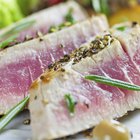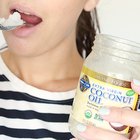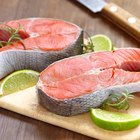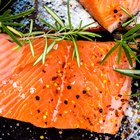
Salmon is widely recognized as an unusually healthy dietary choice, as rich in nutrients as it is in flavor. Salmon skin is completely edible, and is usually included with canned salmon. Some cooks routinely leave it on, while others just as routinely take it off. Either option is healthier than not eating salmon at all.
Salmon and Nutrition
Discussions of healthy diet and lifestyle often include recommendations to eat more fish. One of those mentioned most often is salmon, because of its numerous nutritional virtues. Salmon is one of the best natural sources of omega-3 fatty acids, thought to protect against heart attack and stroke among other serious health concerns. Further, salmon's distinctive pink pigmentation is caused by a potent antioxidant called astaxanthin. Astaxanthin's suspected health benefits are the subject of ongoing study. Salmon is also a source of vitamin D, niacin, vitamin B12 and phosphorous, as well as good-quality protein.
Salmon Skin and Nutrition
Cooking salmon with or without the skin is largely a question of personal preference. Once the salmon has been scaled, there is no pressing culinary reason either to use it or remove it. At most, if pan-seared, the skin will crisp and provide a pleasantly complementary texture. From the health perspective, the skin provides collagen, protein and omega-3 fatty acids, all of which are beneficial. There is a layer of fat just under the skin, the source of the omega-3s. Each cook must decide between the lowest possible fat levels, and the consumption of healthful fats.
Health Concerns
Some reports, including those conducted by the Mayo Clinic, indicate that farmed salmon may contain elevated levels of dioxins and PCBs, both well-recognized as potent carcinogens. Salmon at the market will not usually be identified as farmed, but as a rule, Atlantic salmon is farmed and Pacific salmon is wild-caught. This makes it relatively easy to dodge the issue. Although it is not a major risk, both farmed and wild-caught salmon may also contain mercury. All of these contaminants concentrate in the salmon's fat, and therefore in the layer of fat under the skin.
Recommendations
Eating salmon presents clear-cut health benefits, despite the risks represented by the possible presence of mercury, dioxins and PCBs. The Mayo Clinic comes down on the side of continued consumption of fish, especially salmon, because of the known health benefits of the omega-3s it contains. Those who are especially concerned about contaminants, or those who belong to high-risk groups, such as children and pregnant or nursing women, may wish to remove the skin from their salmon just to be cautious. Otherwise, it remains a question of personal preference.
Related Articles

How to Cook Grunt Fish

How to Pan Sear Sea Bass

Tuna Steaks Nutrition

How to Cook Frozen, Boneless & Skinless ...

How to Cook Mackerel in an Oven

Do You Cook Fish Skin-Side Down?

Skin Benefits of Eating Coconut Oil

What Foods Provide Calcium D-Glucarate?

Difference Between Tilapia Loin and ...

Canned Tuna Vs. Fresh Tuna

How to Cook Salmon Fillet with the Skin ...

Baked Salmon Filet Nutrition Information

How to Cook Fried Catfish Without It ...

Cooking Frozen Swai Fillets
How to Cook Seasoned Keta Salmon

Food Sources of Phosphatidylcholine

How to Clean a Sucker Fish

Are There Foods That Heal Age Spots?

How to Fillet a Goliath Grouper

How Long Does It Take for Salmon to ...
References
- "On Food and Cooking: The Science and Lore of the Kitchen"; Harold S. McGee; 2004
- The Mayo Clinic: Omega-3 In Fish -- How Eating Fish Helps Your Heart
- University of California Cooperative Extension;: Commercially Farmed and Wild-Caught Salmon: Bon Appétit!; Pamela G. Tom, et al.; April 2010
- Phytochemicals.info: Astaxanthin
- Mayo Clinic: Dietary Fats -- Know Which Kinds to Choose
Writer Bio
Fred Decker is a trained chef and prolific freelance writer. In previous careers, he sold insurance and mutual funds, and was a longtime retailer. He was educated at Memorial University of Newfoundland and the Northern Alberta Institute of Technology. His articles have appeared on numerous home and garden sites including GoneOutdoors, TheNest and eHow.
Photo Credits
Jupiterimages/Comstock/Getty Images